
In the years 2013-15, one of my artistic projects was as a co-author of the international art publication The Encyclopaedia of Fernal Affairs, a strange and surreal collection of artworks and stories which included names, words and text passages in a constructed language called Fernalese. This was an exciting venture, not least in its ability to create an entirely new and strangely-connected perceptual reality, and this short essay reflects on the process of creating the language, the grammar of which can be found here.
"The making of language and mythology are related functions. Your language construction will breed a mythology" – J.R.R. Tolkein, A Secret Vice
The Encyclopaedia of Fernal Affairs has as its setting an imaginary Garden of Fernal Delights, a sublime and paradisical place where all the delights of the natural world and of being human, from the sexual to the surreal, the visionary to the instinctive, are celebrated as natural behaviours and perceptions of being alive. Fernalese, or Ferxao in Fernalese, was created to adorn this book and animate the Garden, and reflecting the bounteous pleasure of this imaginary reality.
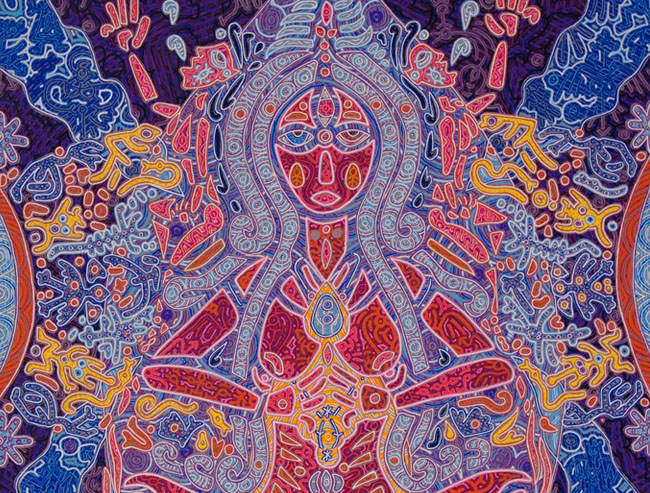
It would have been easy simply to create a kind of calque, in which sounds of words are changed but their meanings and lexical spaces remain the same, or perhaps a set of meaningless but exotic-sounding syllables which would superficially look like a language, but a practiced eye would spot the inconsistencies and randomness. Instead, I wanted to create a fully functional language, and for it to be an artwork in itself: beautiful, magical and of as much perceptual depth as I could muster.
Constructing a language as an artwork, however, is a big undertaking. Let us imagine that one wishes to create a painting. A normal artist would simply buy the canvas and paints, and perhaps stretcher bars or a frame, then begin sketching and painting on the delightful road to completing the artwork. Not so with language as art: before one can begin painting, one must create one’s own tools, and even create the tools used to make tools. It is as if our artist has to first grow his cotton, then learn how to spin and weave it into a viable canvas, learn the carpenter’s trade to make the frame, as well as how to make brushes and even hunting in the wilderness for pigments with which to mix the paints.
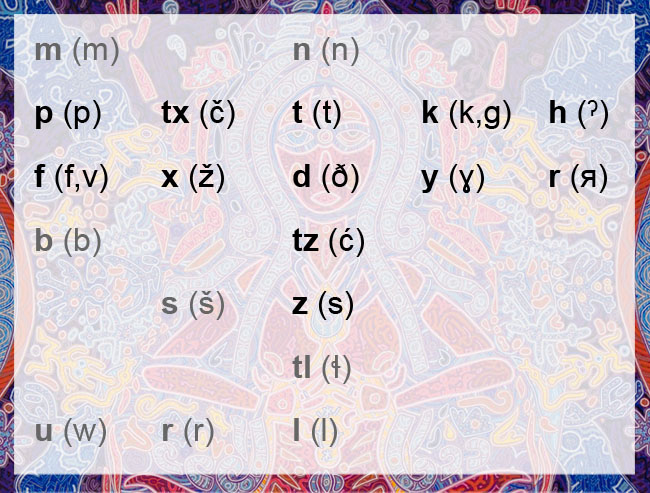
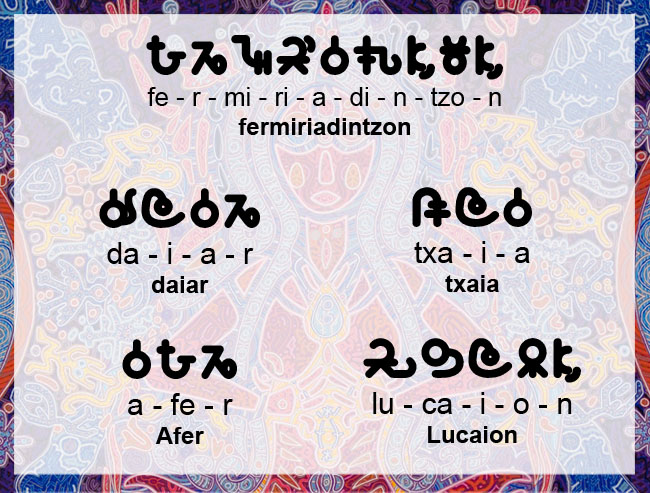
In a language, there are sounds, sequences of sounds, syllable structures, morphemes, parts of speech, word phrases, syntaxes, grammatical arrangements, noun and verb alignments, coordination of meaning and context and many other phenomena which have precise rules and cannot be shirked if the language is to work properly. All of these technical details have to be formulated, constructed and set out, before the delightful process of artistic invention and reality creation can begin.
The Fernalese grammar has plenty of details for the technically-curious, but one very important feature of any language is sound symmetry, the idea that the dynamics of a language’s sounds are consistent. For example, English makes a consistent distinction between voiced (b, d, g) and unvoiced (p, t, k) consonants, as well as between stops (p, ch, t) and fricatives (f, sh, s). With Fernalese, I decided the dynamic would be between unvoiced stops and voiced fricatives as one can see highlighted above. There are exceptions to this rule, and other dynamics as well, but here we set a basic sonic aesthetic for the language.
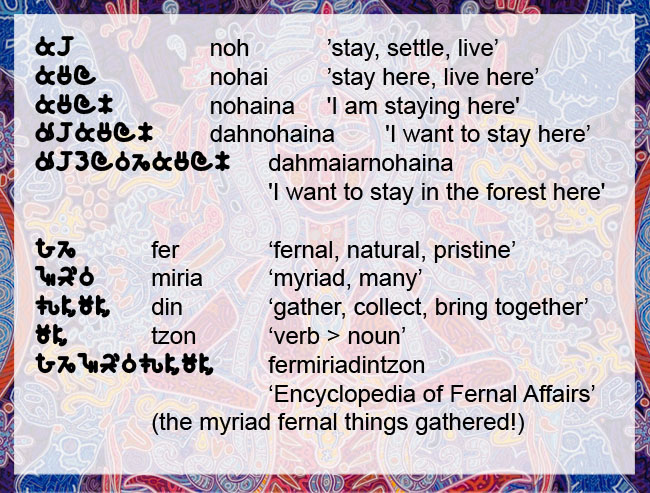
We also have to decide how the language will work, and how words will relate to each other in a sentence or in speech. One common dynamic is isolating versus synthetic. English is mostly isolating: Each. Word. Stands. Alone. But it can also be synthetic, in that words can be made up of lots of parts, as we see in the word unavailability, which contains four bits (un- ‘not’, -avail- ‘be of service to’, -abil- ‘can, able’, and –ity ‘noun’) the whole meaning ‘the notion of not being able to be of service to’. I decided that Fernalese should be extremely synthetic, using this method of lumping parts of meaning together not just for nouns but for verb phrases too, as the above examples demonstrate.
Once some of these rules are set out, the first experimental and creative play can begin. One of the first words to emerge from all of this was fer, which was derived from the word ‘fernal’, itself a neologism coined by Filipino artist Gromyko Semper from the word ‘infernal’. Fernal was a way to express the notion that what was formerly infernal – rejected, hellbound or anathema to traditional religious conceptions – was now to be valued and made paradisical. I wanted to go further and make the Fernalese word fer express a simple and natural delight in being alive, and this was one of the fundamental inspirations for the future course of the language’s development.
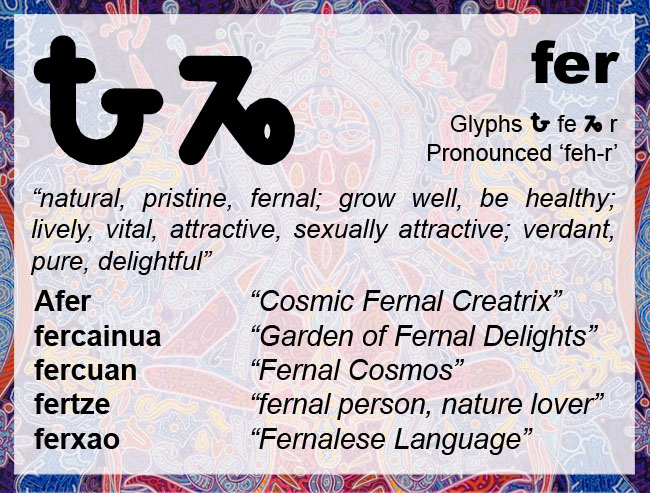
Thus a vision of something pristine, natural, delightful, verdant and lithely sexual was born, and from this I realised that the name of language – ferxao ‘pristine speech’ – should derive from the word. A couple of emergent mythical features also started emerging, not least the presence of Afer, a goddess who was fernality personified, and who quickly became something of a cosmic and primordial figure. Through this fictional but sacred image, a whole range of linguistic features emerged fused with perceptual realities, and the process began to get wonderfully strange.
Among such wonders were a realisation that Afer embodied not merely women, or two genders, but three genders – female, male and queer – and from this sprang a delightful perceptual arrangement that fernal reality was packaged into threes: three words for light, three words for seeing, three words for time, and so on.
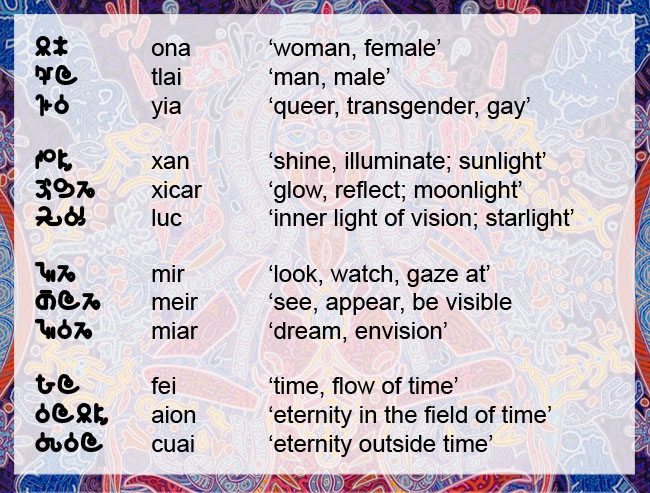
Here Tolkein’s words that language can generate mythology became very prescient, as these triplets combined in various ways to liberate unbidden fernal deities and spirits, the most notable of which was Lucaion, the light of eternity, or more specifically the ‘inner light of vision, relating to eternity within the field of time’! We have seen how Afer sprang from the image of pristine and sexual fer, now Lucaion sprang as a queer hero figure engaging in adventures which responded to some deeply personal innerlight visions and dreams that took place during the course of the language creation. These can be read about in the Song of Lucaion.
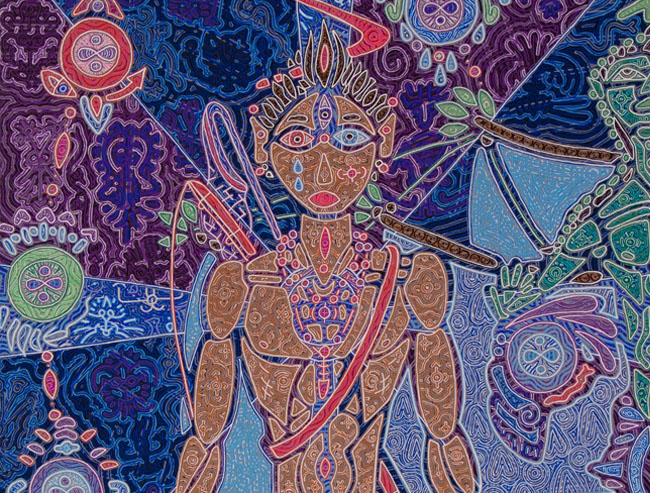
A crucial test for the language’s construction at the early stage is to start building phrases – greetings are a useful way to do this, to see if the language is efficient in expressing simple ideas or if it is ungainly and makes even daily life difficult. I decided early on that Fernalese would not stand on ceremony, and complex ritual phrases that are often seen in languages like Japanese would be absent. Fernalese speakers would thus seek immediate and direct ways of interpersonal connection, and since the fundament was one of naturalness and liveliness, cheerful friendliness became a basic assumption.
I had already begun to invent sentence-coordinating particle words as part of the grammar, and realised that two of these, io, indicating beginnings, and to¸ indicating continuation, could be combined to make io to! ‘hey! hey there!’ as a meaningless but happy greeting which assumed the beginning and continuation of friendship. The word ban ‘good, well, healthy, lively’ was recruited to make the question ‘how are you?’ – bansitxa? literally ‘are you lively?’
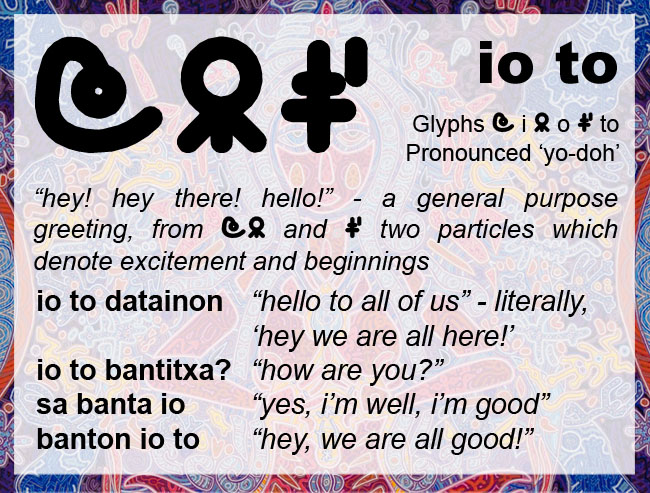
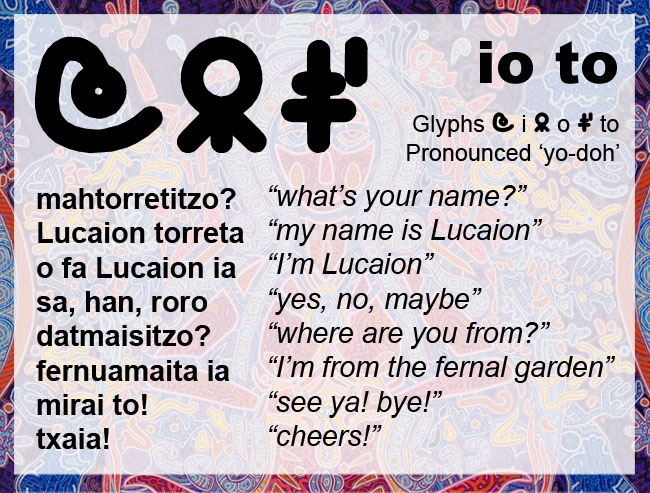
With all these preliminary musings done, the real creative fun could begin, which was to allow the language to open out into a more fully-realised system of expression. There’s a strange perceptual loop that happens when one invents a language: one plants seeds that have sprung from one’s own brain, as little ideas and cursory thoughts, to swing back around as fundamental and motivational forces that encompass the whole of the system you are inventing, which enters one’s subconscious as a new worldview encoded as language rather than as a superficial musing. It is a distinctly odd experience of recirculation: you find yourself using linguistic forms that feel alien yet simultaneously you know you have invented them yourself.
A good example here is the friendliness and lack of ceremony in Fernalese greetings: this seed rapidly became a whole forest of motivational factors, since a lack of hierarchy and directness of communication was implied in the simple friendliness of the phrases. This fused with the paradisical aspects of the imaginary Garden of Fernal Delights and I began to consider: what would a completely egalitarian language, which lacked all forms of ranking and hierarchy, look like?
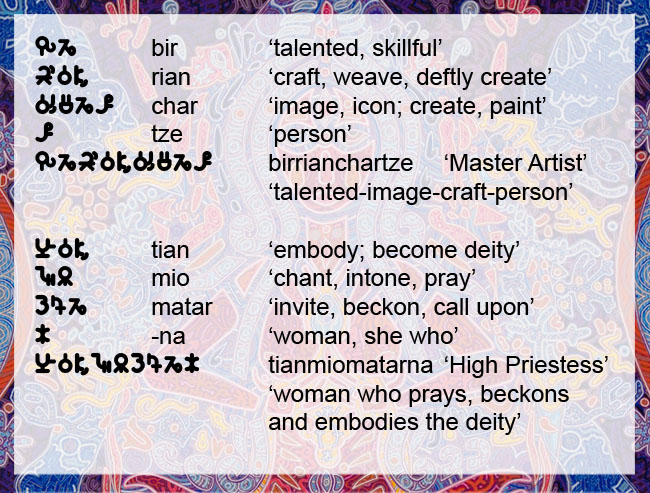
As a first step, I quickly realised that the language would have no official titles or expressions of class, and it became apparent that this would move the language down a different expressive track, challenging the speaker not to rely upon lazy or meaningless hierarchical terms, but upon seeking to speak clearly about the nature and quality of the subject at hand. An excellent example is above, with the common phrase directed at talented artists of being a ‘Master’, which says little about the artist being discussed, but rather discloses their social status or artistic attainment. The Fernalese equivalent, birrianchartze, describes the person’s gifts and talents with lively colour, making no statement about their class or attainment.
Grammatically-speaking, I soon realised that Fernalese should have no comparative or superlative constructions: nothing should ever be better or the best, but instead should be explored on its own terms, again challenging the speaker to directly perceive the thing itself, rather than how others or the world might see it. Thus we could say, in English, ‘Mexico is hotter than England’, but a hypothetical Fernalese speaker would prefer to explore both Mexico and England in their own delightful forms, with a comparative perhaps only implied: ‘Mexico is tropically warm, while England is changeable and cold.’ This distinction isn’t merely semantic: it seeks to express a subtly different way of being.
There is also no Fernalese word for ‘do’: again here, the challenge is to express the notion of ‘doing’ with more commitment and colour than in English, and so words such as tin ‘complete, finish’, caire ‘enjoy, take delight in’ and tel ‘perform a service’ become prominent here.
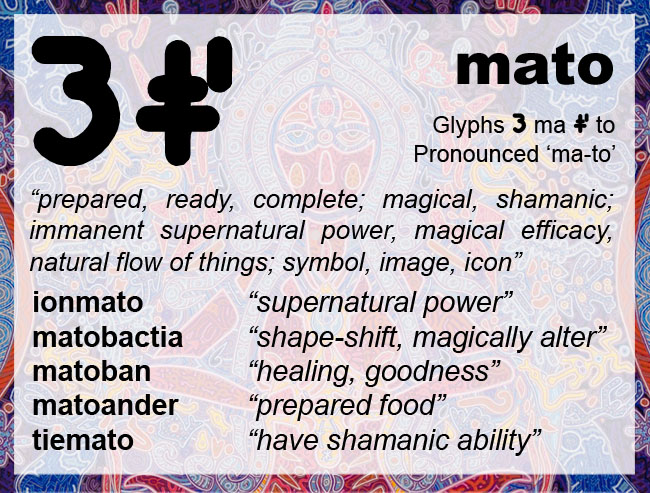
Another important factor in creating Fernalese was to ensure that many different human realities were enfolded into its make-up, so that it didn’t just unconsciously become a language that solely expressed Western concepts and cultural forms. As such, ideas from a variety of indigenous languages were imported into Fernalese, and perhaps the most obvious one was mato, whose meanings of shamanic readiness and magical intent were derived from the Mazatec word chjine, which refers to a state of readiness-to-serve which is the hallmark of a true shaman in their culture. Thus mato has both magical and mundane associations, and this fusion of both sacred and everyday is an important feature of Fernalese.
All of these ingredients could now be entered into a rolling process whereby images of language are driven by metaphor, to create novel links between ideas found nowhere else. Sometimes resembling miniature moments of conceptual art, these new words occupied their own lexical spaces, lacking a single one-to-one correspondence with words in any natural human language. Thus for example, lightning could be taken as a metaphor for inspiration, while its resemblance to a tree branch was understood as indicating diversity or eclecticism, a lexical trackway which came to form the Fernalese word daiar.
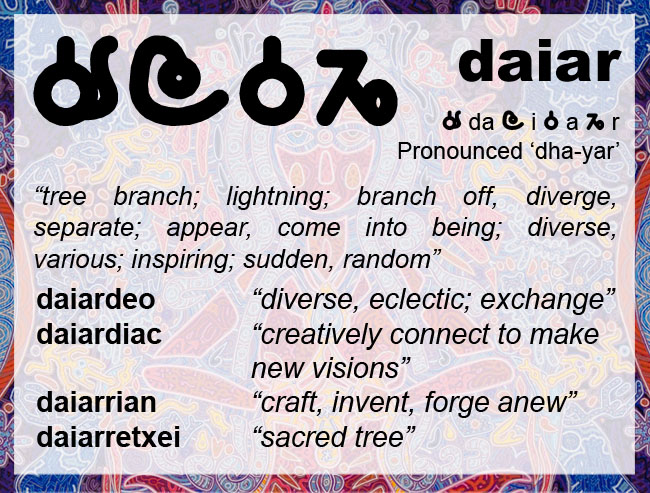
Some of these ideas could be deeply challenging. In our modern world, identity is a deeply important part of our character: we are artists and lawyers, gay, black or Chinese, female and male. But in the Garden of Fernal Delights, where shape-shifting, costume changes, fusion from one form into another or the combination of several creatures into hive minds and bodies, such firm statements of permanent identity are anathema. And thus was born the image of Fernal identity.
The word txan literally means ‘to ride, be carried’ or to simply ‘go with the flow of things’, but it also covers ideas of identity, attributes, character and properties. The idea here is that identity is something you ‘ride’: it is not a permanent feature of your being, but something which changes from moment-to-moment. In a stressful situation, your character might not be that similar to when you are at home relaxing with friends, and so txan implicitly assumes the Fernalese notion of looking at what is, rather than what is thought to be. Txan also means ‘who?’ because in fernalese, interrogative words are verbs.
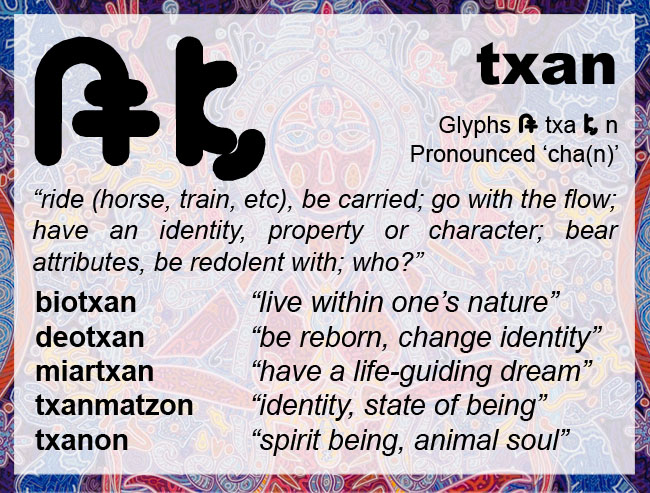
A third example is tero, an extremely complex word which started out life as a simple way to express travelling or voyaging. From here, it graduated into referring to journeys and adventures, and at length mythical epics and legendary tales. Using image as metaphor again, though, and considering lifelong learning as a kind of journey, liberated meanings of academic study and as a suffix ‘-ology’ to refer to academic disciplines.
At the same time, travelling liberated another image, in the experience of the constant flow of consciousness as a kind of travel, and thus tero began to mean ‘state of mind, state of consciousness’. From this nexus of meanings sprang a whole range of words which simultaneously highlighted academic studies and visionary states of consciousness.
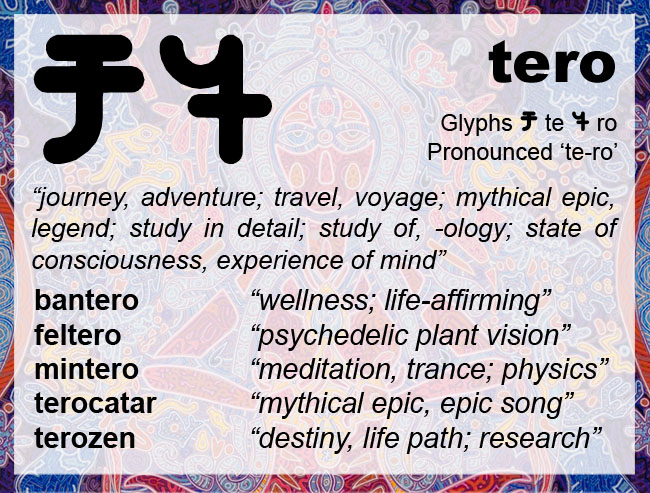
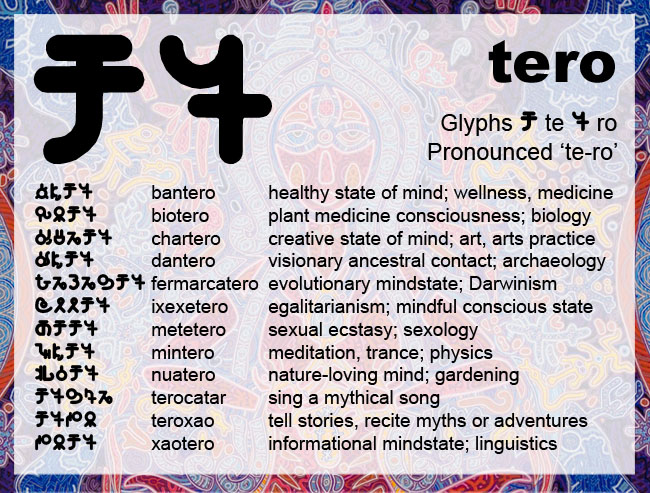
Continuing the quest to create strange perceptions of reality, and mindful of the Fernalese love of threes, I then decided to interrogate perception itself, coming to the idea that each sense could be expressed in three ways, dependent on the focus or intention of the action: i) the sense action moves from inner to outer, ii) the sense action moves from outer to inner, and finally iii) the sense action circulates within. In many ways this was building upon the natural English distinctions between ‘look’ and ‘see, and between ‘listen’ and ‘hear’, but with an additional third dynamic and applied to many other senses and ideas, liberating ideas of dreaming as a kind of seeing and the soul as an inwardly-expressed bodily sensation.
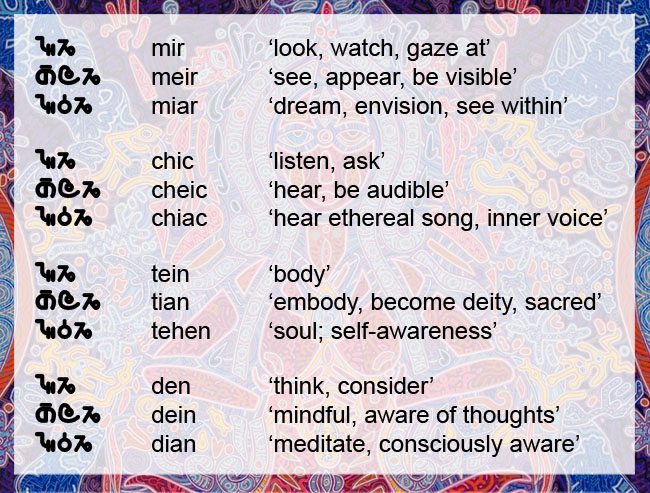
Thus Fernalese can be seen as a kind of grand experiment in perceptual reality, attempting to create a language which reflects more deeply the human capacities for visionary and altered states, whilst keeping true to a sense of playful egalitarianism which are the hallmarks of the Garden of Fernal Delights. But this reality-hacking wasn’t the only part of the language – there was mythology too, and aside from Lucaion And Afer, other figures emerged from words in the language.
Perhaps the most amusing of these was Metehuia ‘Foresight Trickster’ who is a kind of Fernal Prometheus. He sprang into existence the moment the Fernalese word meteo, which combines both sexual and prophetic meanings, was created, and quickly got himself involved in a cosmic farce with Tzihuia the Sky Trickster and Chianuia the Ocean Trickster. The –huia element of their names, meaning ‘trickster’, was quickly complemented by another name element –sai ‘blessing’ and as such Mirosai ‘Water Blessing’ and Menesai ‘Menstrual Blessing’ were born and began to sing their creative song in the Ocean Garden.
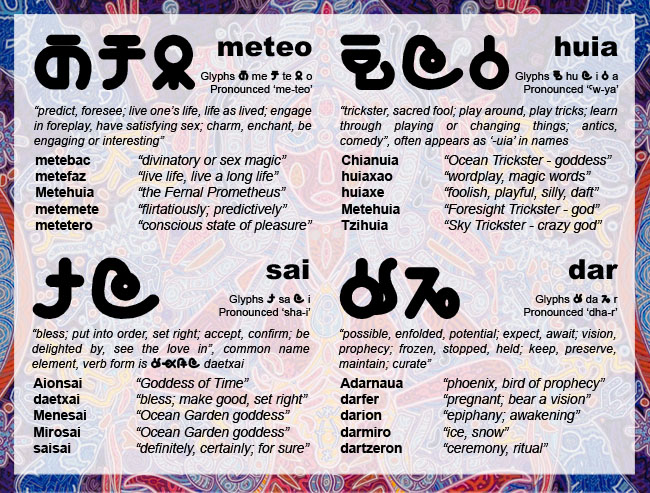
The culmination of all this art-language-mythical creative process took place when the time came to produce five Fernalese poems to adorn artworks in my Fernal World series. These poems were made part in English and part in Fernalese, and the invention of new words drove the various processes described above ever faster. I quickly came up with an aesthetically-pleasing and poetic idea of clause symmetry, where instead of making lines of a poem rhyme, or having a certain number of syllables in a stanza, instead the phrases within each stanza would be as symmetrically-framed as possible, as these excerpts from the Song of Mirosai and Menesai demonstrate:
bring forth Mirosai from water drops, I will shine brightly as the Moon, |
e miromaico Mirosaico tore io zaeten zezehxicarihua io |
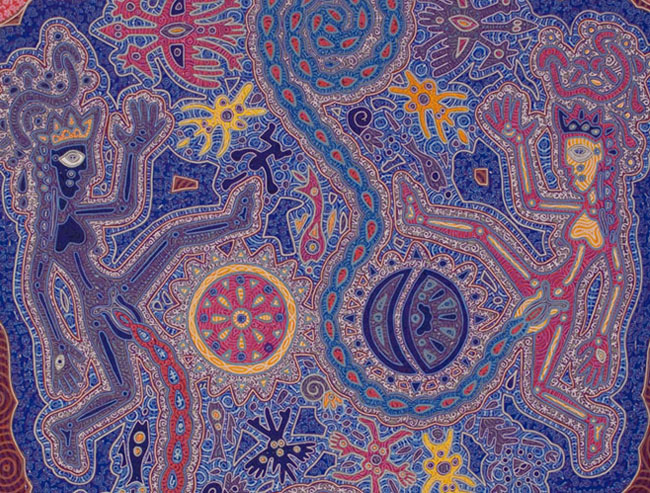
All sorts of symmetries can be seen here, from miromaico and Mirosaico in the first line, to the –carro to endings in the second line, and the variations with zezehxicarihua io/to and afer-…-re in the second stanza. This is something I am still developing along with poetic myth cycles such as the Thirteen Songs and the Song of Lucaion, and a big project lays in wait ahead of me if and when I ever decide to translate those longform poems into Fernalese, a process which will surely liberate further wild and strange mythologies and reality-perceptions.
As a final demonstration of the language, here is a short film which includes a brief spoken passage of mythology narrating how the Fernal Creatrix Afer created the Garden of Fernal Delights. While my pronunciation isn’t exact as ‘Fernalese’ as I’d like, it stands as a work-in-progress, and shows perhaps in the most accessible way the artistry and intentions behind this pristine speech I call Ferxao, the Fernalese language.
Afer - A Fernalese Film from Bruce Rimell on Vimeo.
:: BIBLIOGRAPHY ::
Helge Kåre Fauskanger, Tolkien's Not-So-Secret Vice, url: http://folk.uib.no/hnohf/vice.htm, retrieved April 2015
Bruce Rimell, Ferxao: The Fernalese Language, url: http://www.biroz.net/fernalese/, retrieved March 2015
Mark Rosenfelder, The Language Construction Kit, url: http://www.zompist.com/kit.html, retrieved October 2004
J.R.R. Tolkein, A Secret Vice, Lecture given in 1931, url: http://idiom.ucsd.edu/~bakovic/tolkien/secret_vice.pdf, retrieved April 2015
![]()

